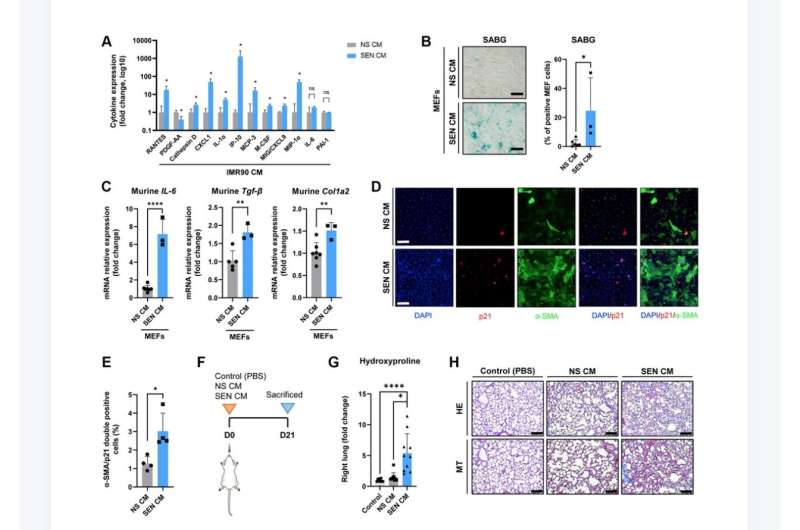This article has been reviewed according to Science X's editorial process and policies. Editors have highlighted the following attributes while ensuring the content's credibility:
fact-checked
proofread
Study: Human senescent fibroblasts cause lung fibrosis in mice

A new research paper was published on the cover of Aging, titled "Human senescent fibroblasts trigger progressive lung fibrosis in mice."
Cell senescence has recently emerged as a potentially relevant pathogenic mechanism in fibrosing interstitial lung diseases (f-ILDs), particularly in idiopathic pulmonary fibrosis. In a new study, researchers from Hospital Clinic Barcelona, The Barcelona Institute of Science and Technology (BIST), Instituto de Investigaciones Biomédicas August Pi i Sunyer (IDIBAPS), Centro de Investigación Biomédica en Red Enfermedades Respiratorias (CIBERES), University of Barcelona, Karolinska Institute, Catalan Institution for Research and Advanced Studies (ICREA), and Altos Labs hypothesized that senescent human fibroblasts may suffice to trigger a progressive fibrogenic reaction in the lung.
"Here we: (1) explored this hypothesis in vivo; (2) investigated the potential underlying biological mechanisms in vitro; and (3) studied the effects of one experimental senolytic compound (navitoclax) and two anti-fibrotic drugs currently used in the treatment of IPF in humans (nintedanib and pirfenidone), both in vivo and in vitro," state the authors.
To address this, senescent human lung fibroblasts, or their secretome (SASP), were instilled into the lungs of immunodeficient mice. The researchers found that human senescent fibroblasts engraft in the lungs of immunodeficient mice and trigger progressive lung fibrosis associated to increasing levels of mouse senescent cells, whereas non-senescent fibroblasts do not trigger fibrosis.
They also found that the SASP of human senescent fibroblasts is pro-senescence and pro-fibrotic both in vitro when added to mouse recipient cells and in vivo when delivered into the lungs of mice, whereas the conditioned medium (CM) from non-senescent fibroblasts lacks these activities. Finally, navitoclax, nintedanib and pirfenidone were found to ameliorate lung fibrosis induced by senescent human fibroblasts in mice, while only navitoclax displayed senolytic activity.
"We conclude that human senescent fibroblasts, through their bioactive secretome, trigger a progressive fibrogenic reaction in the lungs of immunodeficient mice that includes the induction of paracrine senescence in the cells of the host, supporting the concept that senescent cells actively contribute to disease progression in patients with f-ILDs," say the researchers.
More information: Fernanda Hernandez-Gonzalez et al, Human senescent fibroblasts trigger progressive lung fibrosis in mice, Aging (2023). DOI: 10.18632/aging.204825




















